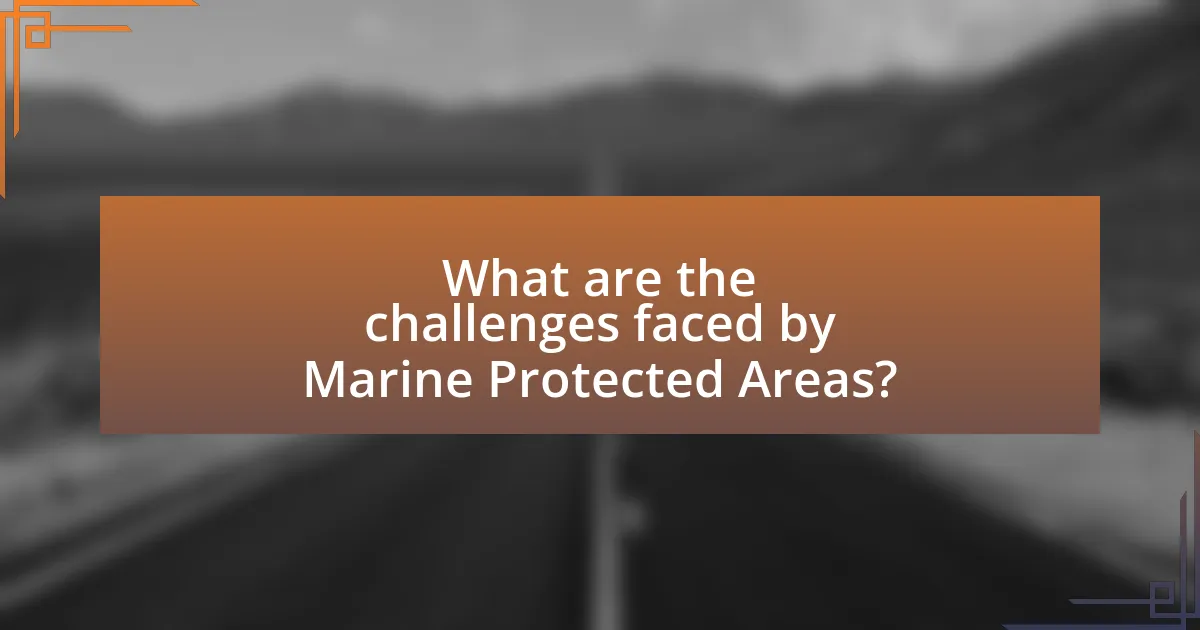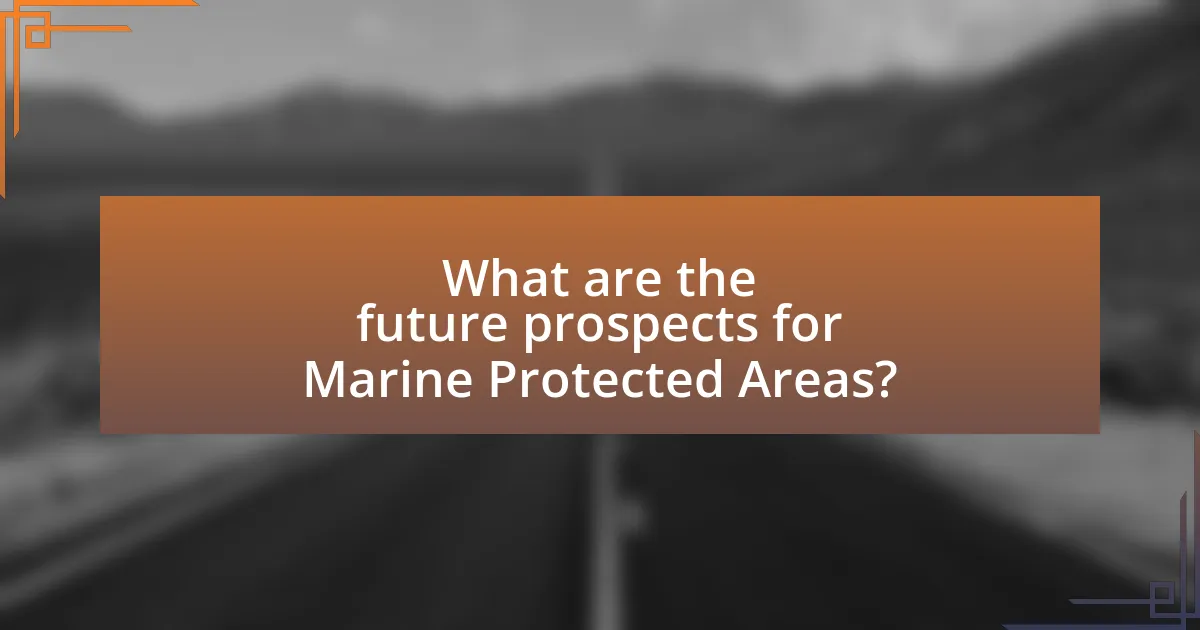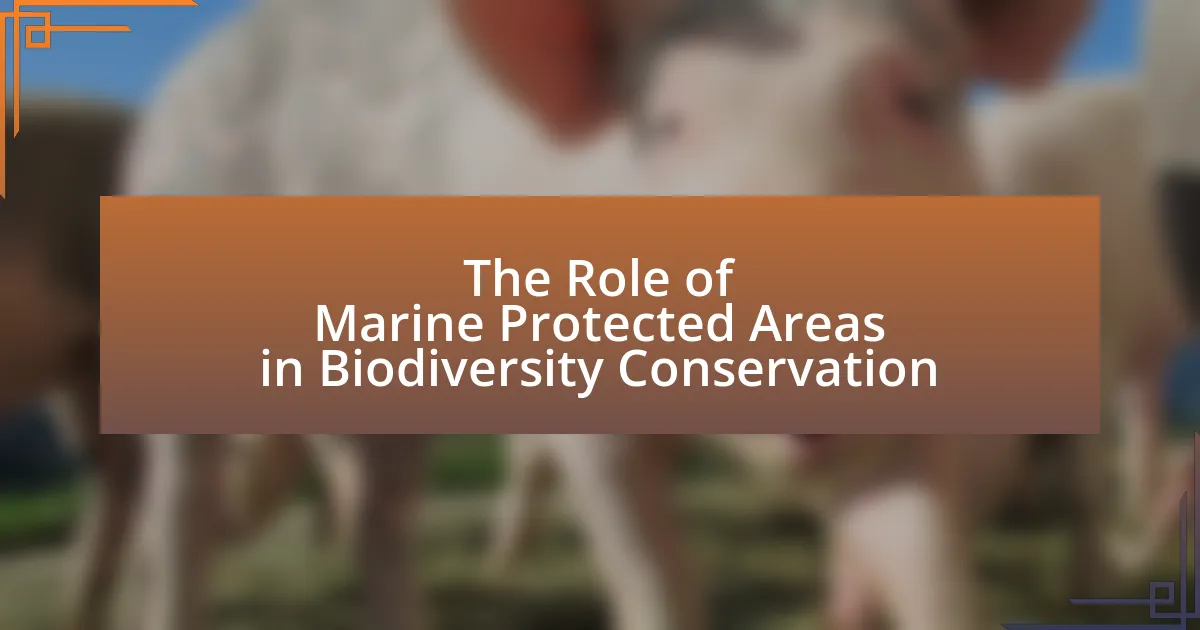Marine Protected Areas (MPAs) are designated regions in marine environments aimed at conserving biodiversity and ecosystems by restricting human activities such as fishing and pollution. This article explores the significance of MPAs in biodiversity conservation, detailing their role in protecting various ecosystems, enhancing fish populations, and supporting endangered species. It also addresses the challenges faced by MPAs, including illegal fishing and climate change, and highlights the importance of effective governance, stakeholder engagement, and technology in improving MPA management. Additionally, the article discusses practical steps individuals and communities can take to support MPAs and promote sustainable tourism practices within these protected areas.
-1.webp)
What are Marine Protected Areas (MPAs)?
Marine Protected Areas (MPAs) are designated regions in marine environments where human activities are restricted to conserve biodiversity and ecosystems. These areas aim to protect marine species and habitats from overfishing, pollution, and habitat destruction, thereby enhancing the resilience of marine ecosystems. According to the International Union for Conservation of Nature (IUCN), MPAs can significantly contribute to the recovery of fish populations and the overall health of marine environments, with studies showing that well-managed MPAs can lead to a 20-50% increase in fish biomass within their boundaries.
How do MPAs contribute to biodiversity conservation?
Marine Protected Areas (MPAs) contribute to biodiversity conservation by providing safe habitats that protect marine species and ecosystems from human activities. These designated areas restrict activities such as fishing, mining, and coastal development, allowing ecosystems to recover and thrive. Research indicates that MPAs can lead to increased species richness and abundance; for example, a study published in the journal “Nature” found that fish populations in MPAs can be up to 600% larger than in unprotected areas. Additionally, MPAs help maintain ecosystem services, such as carbon sequestration and water filtration, which are vital for overall marine health.
What types of ecosystems are typically protected by MPAs?
Marine Protected Areas (MPAs) typically protect a variety of ecosystems, including coral reefs, mangroves, seagrass beds, and estuaries. These ecosystems are crucial for biodiversity, providing habitat for numerous marine species and serving essential ecological functions. For instance, coral reefs support about 25% of all marine life despite covering less than 1% of the ocean floor, highlighting their importance in biodiversity conservation. Additionally, mangroves act as vital nurseries for fish and protect coastal areas from erosion, while seagrass beds contribute to water quality and carbon sequestration. The protection of these ecosystems through MPAs is supported by various studies, including the Global Ocean Refuge System report, which emphasizes the role of MPAs in safeguarding marine biodiversity and ecosystem services.
How do MPAs differ from other conservation strategies?
Marine Protected Areas (MPAs) differ from other conservation strategies primarily by their focus on protecting marine ecosystems through designated zones where human activities are restricted or regulated. Unlike general conservation strategies that may apply to terrestrial or freshwater environments, MPAs specifically target the preservation of marine biodiversity, habitats, and resources. For example, according to the International Union for Conservation of Nature, MPAs can reduce fishing pressure, allowing fish populations to recover and ecosystems to thrive, which is a distinct approach compared to land-based conservation efforts that may not address marine-specific challenges.
Why are MPAs important for marine biodiversity?
Marine Protected Areas (MPAs) are crucial for marine biodiversity because they provide safe habitats that allow ecosystems to thrive and recover from human impacts. MPAs help to conserve critical habitats, such as coral reefs and mangroves, which support diverse marine species. Research indicates that MPAs can lead to increased fish populations and biodiversity, with studies showing that fish biomass can increase by up to 600% within protected areas compared to unprotected regions. This enhancement of biodiversity is essential for maintaining ecosystem resilience, ensuring the sustainability of marine resources, and supporting fisheries that many communities rely on for their livelihoods.
What role do MPAs play in protecting endangered species?
Marine Protected Areas (MPAs) play a crucial role in protecting endangered species by providing safe habitats that limit human activities such as fishing, pollution, and habitat destruction. These designated areas help to conserve biodiversity by allowing ecosystems to recover and thrive, which is essential for the survival of endangered species. For instance, studies have shown that MPAs can lead to increased populations of threatened species, as seen in the case of the recovery of the Nassau grouper in the Caribbean, where protective measures resulted in a significant population rebound. Additionally, MPAs contribute to the overall health of marine ecosystems, which supports the resilience of endangered species against environmental changes and human impacts.
How do MPAs help in restoring degraded marine habitats?
Marine Protected Areas (MPAs) help restore degraded marine habitats by providing a refuge for marine life, allowing ecosystems to recover from overfishing, pollution, and habitat destruction. MPAs reduce human activities such as fishing and coastal development, which can lead to the regeneration of fish populations and the restoration of coral reefs and seagrass beds. Research indicates that MPAs can increase fish biomass by an average of 446% within their boundaries, as reported in a study published in “Nature” by Edgar et al. (2014). This recovery not only enhances biodiversity but also improves ecosystem services, such as water quality and resilience to climate change.

What are the challenges faced by Marine Protected Areas?
Marine Protected Areas (MPAs) face several significant challenges that hinder their effectiveness in biodiversity conservation. One major challenge is illegal fishing, which undermines conservation efforts by depleting fish stocks and disrupting ecosystems. According to a study published in the journal “Marine Policy,” illegal fishing can account for up to 30% of total fish catch in some regions, severely impacting marine biodiversity. Another challenge is inadequate funding and resources, which limits the ability to enforce regulations and manage MPAs effectively. Research from the World Wildlife Fund indicates that many MPAs operate with budgets insufficient for proper surveillance and management, leading to poor compliance with conservation measures. Additionally, climate change poses a critical threat, as rising sea temperatures and ocean acidification can alter habitats and species distributions, complicating conservation strategies. A report by the Intergovernmental Panel on Climate Change highlights that marine ecosystems are particularly vulnerable to these changes, further stressing the importance of effective MPA management.
How do human activities impact the effectiveness of MPAs?
Human activities significantly undermine the effectiveness of Marine Protected Areas (MPAs) by introducing pollution, overfishing, and habitat destruction. For instance, coastal development and agricultural runoff lead to nutrient loading and sedimentation, which can harm marine ecosystems within MPAs. A study published in “Nature” by Edgar et al. (2014) found that MPAs with stricter regulations on human activities showed a 20% increase in fish biomass compared to those with less stringent protections. Additionally, illegal fishing within MPAs can deplete fish populations, counteracting conservation efforts. Therefore, the presence and intensity of human activities directly correlate with the success of MPAs in preserving marine biodiversity.
What are the common threats to MPAs from fishing and tourism?
Common threats to Marine Protected Areas (MPAs) from fishing include overfishing, bycatch, and habitat destruction, while tourism poses risks such as pollution, habitat degradation, and disturbance to wildlife. Overfishing depletes fish populations and disrupts ecosystem balance, with studies indicating that 34% of global fish stocks are overfished. Bycatch, the unintended capture of non-target species, can lead to significant declines in biodiversity. Habitat destruction occurs through destructive fishing practices like bottom trawling, which can devastate marine habitats.
Tourism-related threats include pollution from boats and coastal development, which can harm marine ecosystems. Additionally, increased human activity can disturb nesting sites and breeding grounds for various marine species. Research shows that unmanaged tourism can lead to a 50% decline in sensitive marine species in heavily visited areas. These threats collectively undermine the conservation goals of MPAs, which are designed to protect marine biodiversity.
How does climate change affect MPAs and their biodiversity?
Climate change negatively impacts Marine Protected Areas (MPAs) and their biodiversity by altering marine ecosystems, leading to habitat loss and species decline. Rising sea temperatures cause coral bleaching, which affects the health of coral reefs that serve as critical habitats for numerous marine species. Additionally, ocean acidification, a direct result of increased carbon dioxide levels, disrupts the calcification processes of shellfish and other marine organisms, threatening their survival. According to a study published in “Nature Climate Change,” approximately 30% of marine species are projected to face increased extinction risks due to climate change effects on their habitats within MPAs. These changes undermine the primary purpose of MPAs, which is to conserve biodiversity and protect vulnerable marine ecosystems.
What governance and management issues affect MPAs?
Governance and management issues that affect Marine Protected Areas (MPAs) include inadequate legal frameworks, insufficient funding, and lack of stakeholder engagement. Inadequate legal frameworks can lead to unclear regulations, making enforcement difficult and reducing the effectiveness of MPAs. Insufficient funding hampers the ability to implement management plans and conduct necessary research and monitoring, which are critical for the success of MPAs. Furthermore, lack of stakeholder engagement can result in conflicts and non-compliance, as local communities may feel excluded from decision-making processes. These issues collectively undermine the conservation goals of MPAs, as evidenced by studies indicating that well-governed MPAs with active community involvement are more successful in achieving biodiversity conservation outcomes.
How can stakeholder engagement improve MPA management?
Stakeholder engagement can significantly improve Marine Protected Area (MPA) management by fostering collaboration and ensuring that diverse perspectives are considered in decision-making processes. Engaging stakeholders, including local communities, fishers, and conservation organizations, leads to more effective management strategies that reflect the needs and values of those directly affected by MPAs. Research indicates that MPAs with active stakeholder involvement are more likely to achieve conservation goals, as evidenced by a study published in “Conservation Biology” which found that participatory governance models enhance compliance and support for conservation measures. This collaborative approach not only increases the legitimacy of management decisions but also promotes shared responsibility, ultimately leading to better ecological outcomes and sustainable use of marine resources.
What are the best practices for monitoring MPA effectiveness?
The best practices for monitoring Marine Protected Area (MPA) effectiveness include establishing clear objectives, using a combination of ecological and socio-economic indicators, and employing adaptive management strategies. Clear objectives guide the monitoring process by defining what success looks like, while ecological indicators such as species diversity and biomass provide measurable data on biodiversity outcomes. Socio-economic indicators, including community engagement and economic benefits, assess the human dimensions of MPAs. Adaptive management allows for ongoing adjustments based on monitoring results, ensuring that management strategies remain effective over time. Studies have shown that MPAs with well-defined objectives and robust monitoring frameworks lead to improved biodiversity outcomes, as evidenced by the increase in fish populations in MPAs compared to unprotected areas.

What are the future prospects for Marine Protected Areas?
The future prospects for Marine Protected Areas (MPAs) are promising, as they are increasingly recognized as essential tools for biodiversity conservation and sustainable fisheries management. Research indicates that well-managed MPAs can enhance marine biodiversity, improve fish stocks, and increase resilience to climate change. For instance, a study published in “Nature” by Edgar et al. (2014) found that MPAs can lead to a 446% increase in biomass of fish populations compared to unprotected areas. Furthermore, global commitments, such as the Convention on Biological Diversity’s goal to protect 30% of the ocean by 2030, are driving the expansion and effectiveness of MPAs. These initiatives suggest a growing recognition of the importance of MPAs in maintaining healthy marine ecosystems and supporting livelihoods dependent on marine resources.
How can technology enhance the management of MPAs?
Technology can enhance the management of Marine Protected Areas (MPAs) by providing advanced tools for monitoring, data collection, and analysis. For instance, satellite imagery and remote sensing technologies enable real-time tracking of environmental changes and human activities within MPAs, allowing for timely interventions. Additionally, the use of Geographic Information Systems (GIS) facilitates spatial analysis, helping managers visualize and assess the effectiveness of conservation strategies. A study published in the journal “Conservation Biology” highlights that integrating technology in MPA management can lead to improved compliance with regulations and better resource allocation, ultimately supporting biodiversity conservation efforts.
What role does data collection play in MPA success?
Data collection is essential for the success of Marine Protected Areas (MPAs) as it informs management decisions and measures the effectiveness of conservation efforts. Accurate data on biodiversity, habitat conditions, and human activities allows for adaptive management strategies that can respond to changing environmental conditions and threats. For instance, studies have shown that MPAs with robust monitoring and data collection protocols are more effective in achieving biodiversity conservation goals, as evidenced by the increased fish populations and improved ecosystem health in well-monitored areas compared to those with limited data.
How can community involvement shape the future of MPAs?
Community involvement can significantly shape the future of Marine Protected Areas (MPAs) by fostering local stewardship and enhancing compliance with conservation measures. Engaging communities in the planning and management of MPAs leads to better alignment of conservation goals with local needs, resulting in increased support for regulations. Studies show that when local communities participate in decision-making, there is a 50% increase in adherence to conservation practices, as evidenced by the success of community-managed MPAs in places like the Philippines, where local governance has led to improved fish stocks and biodiversity. This collaborative approach not only empowers communities but also ensures that MPAs are more effective in achieving their conservation objectives.
What practical steps can be taken to support MPAs?
To support Marine Protected Areas (MPAs), stakeholders can implement several practical steps, including establishing effective management plans, enhancing community engagement, and securing sustainable funding. Effective management plans involve setting clear objectives, monitoring biodiversity, and enforcing regulations to prevent illegal activities. Community engagement is crucial, as involving local populations in decision-making fosters stewardship and compliance; studies show that communities with a stake in MPAs are more likely to support conservation efforts. Securing sustainable funding through government grants, private investments, and partnerships with NGOs ensures that MPAs have the necessary resources for long-term success. These steps collectively enhance the effectiveness of MPAs in conserving biodiversity.
How can individuals contribute to the conservation of MPAs?
Individuals can contribute to the conservation of Marine Protected Areas (MPAs) by participating in local conservation efforts, advocating for policy changes, and practicing sustainable behaviors. Engaging in community clean-up events helps reduce pollution in marine environments, while advocating for stronger protections can influence legislation that supports MPAs. Additionally, individuals can adopt sustainable fishing practices and reduce plastic use, which directly benefits marine ecosystems. Research indicates that community involvement in conservation leads to improved outcomes for biodiversity, as seen in studies highlighting the success of local stewardship in various MPAs worldwide.
What are the best practices for sustainable tourism in MPAs?
The best practices for sustainable tourism in Marine Protected Areas (MPAs) include implementing strict visitor management, promoting eco-friendly activities, and engaging local communities. Strict visitor management, such as limiting the number of tourists and establishing designated pathways, helps minimize environmental impact and protect sensitive habitats. Promoting eco-friendly activities, like snorkeling and kayaking, encourages low-impact exploration of marine ecosystems while educating visitors about conservation. Engaging local communities ensures that tourism benefits them economically and fosters stewardship of natural resources, as evidenced by studies showing that community involvement in tourism leads to better conservation outcomes.
